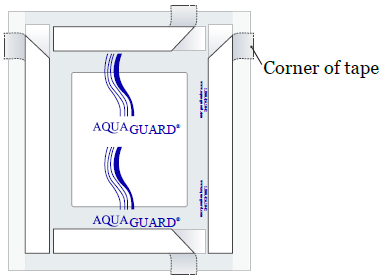This information will help you care for your chest tube and Heimlich valve after you’re discharged (released) from the hospital. The Heimlich valve is also referred to as the Cook® chest drain valve.
About Your Chest Tube and Heimlich Valve
Your chest tube is a flexible tube that’s placed between your ribs. It goes into your pleural space, the area between the inner and outer linings of your lungs. A Heimlich valve is a 1-way valve that connects to your chest tube (see Figure 1). Your chest tube and valve let extra air, extra fluid, or both out of your chest. This lets your lung expand fully.

Figure 1. Chest tube and Heimlich valve
How long you’ll have your chest tube and Heimlich valve depends on your surgery. It also depends on the amount of drainage you’re having. Everyone’s drainage is different. Some people drain a lot, some only a little. You may be discharged from the hospital with your chest tube and valve. This happens if you still have fluid drainage or your lung is still leaking air after your surgery.
Caring for Your Chest Tube
Your chest tube will be covered with a bandage.
- Keep your bandage clean and dry.
- Change your bandage every 7 days. Follow the steps in the “How to change your chest tube bandage” section. Your nurse will also show you how before you leave the hospital.
- If your bandage is wet, dirty, loose, or starts to lift from your skin, change it right away.
Your chest tube may irritate your chest wall, causing some pain. Your healthcare provider may give you a prescription for a pain medication you can take to help with the pain. If the medication doesn’t ease your pain, call your healthcare provider’s office.
How to change your chest tube bandage
-
Gather your supplies. You’ll need:
- Medical tape.
- 4 (4-inch x 4-inch) gauze pads.
- A clean pair of scissors.
-
Wash your hands well with soap and warm water or use an alcohol-based hand sanitizer.
- If you’re washing your hands with soap and water, wet your hands with warm water and apply soap. Rub your hands together for at least 20 seconds, then rinse. Dry your hands with a paper towel. Use that same towel to turn off the faucet.
- If you’re using an alcohol-based hand sanitizer, be sure to cover all parts of your hands with it. Rub your hands together until they’re dry.
- Take off your chest tube bandage. Make sure you don’t pull on your chest tube. Put the bandage in the trash.
- Repeat step 2 to clean your hands again.
- Clean the area around your chest tube with soap and warm water. Let the area air dry.
- Open 2 of the gauze pads. Place one of the gauze pads on top of the other. Using clean scissors, cut a slit halfway up the middle of the gauze pads (see Figure 2).
- Place the cut gauze pads around your chest tube at the insertion site (see Figure 3). The insertion site is the place where your chest tube comes out of your body.

Figure 2. Cutting the gauze
pads

Figure 3. Placing the gauze pads around your chest tube
- Open the other 2 gauze pads. Place one of the gauze pads on top of the other. Then place them over your insertion site, over the cut gauze pads around your chest tube.
- Put medical tape over the whole bandage.
Instructions for showering
You can take showers, but make sure you keep your chest tube bandage dry.
- Cover your chest tube bandage with a waterproof dressing (such as AquaGuard®) before you get in the shower.
- Use a hand-held showerhead if you have one. A hand-held showerhead can help direct the water away from your bandage.
- If your bandage gets wet, change it. Wet bandages are a common cause of skin problems.
Do not take a bath, use a hot tub, go swimming, or submerge yourself in water (go under water) while your chest tube is in place. If you submerge yourself in water by accident, call your healthcare provider’s office.
How to use an AquaGuard waterproof dressing
Follow these instructions to put an AquaGuard waterproof dressing over your chest tube bandage before you shower. Make sure the AquaGuard sticks to your skin, not your bandage.
- Make sure the skin around your chest tube bandage is clean and dry.
-
Take the AquaGuard sheet out of the plastic packaging. The edges of the AquaGuard have tape you can peel off. Fold over a corner of the tape on each side (see Figure 4).

Figure 4. Folding the AquaGuard tape
- Peel off the top strip of tape and place the top edge of the AquaGuard above your bandage. Press down firmly so it sticks to your skin.
- Peel off one of the side strips of tape and press that edge against your skin. If there’s any extra material, pinch it together so it forms a pleat. Fold the pleat down.
- Repeat step 4 with the opposite side of the AquaGuard.
- Repeat step 4 with the bottom of the AquaGuard.
To take the AquaGuard off, start at the top left or right corner. Gently peel the AquaGuard down. Try to peel it in the same direction your hair is growing. Make sure you don’t pull on your chest tube bandage or chest tube.
Emptying Your Heimlich Valve
The first few days after your surgery, the fluid draining from your chest may be dark red. This is common. As you heal, it may look pink or pale yellow.
If fluid is draining from your chest, your Heimlich valve will be connected to a small plastic container or a drainage bag. The type of collection device you have depends on how much fluid is draining.
How often you need to empty your collection device depends on how much fluid is draining from your chest. Everyone’s drainage is different. Your nurse will tell you what to expect before you leave the hospital.
If your valve is connected to a small plastic container, follow these steps:
- Check how much fluid is in the container. Write down the amount in your drainage log. If it’s more than 100 milliliters (mL), call your healthcare provider’s office after you finish emptying the container.
- Open the container. Empty the fluid into the toilet.
- Close the container. Wipe it with an alcohol pad. Put the alcohol pad in the trash. Flush the toilet.
- Wash your hands well with soap and warm water or use an alcohol-based hand sanitizer.
If your valve is connected to a drainage bag, follow these steps:
- Check how much fluid is in the drainage bag. Write down the amount in your drainage log. If it’s more than 100 milliliters (mL), call your healthcare provider’s office after you finish emptying the bag.
- Sit or stand so the valve at the bottom of the bag is over the toilet.
- Open the valve so the fluid can drain into the toilet.
- Close the valve. Wipe it with an alcohol pad. Put the alcohol pad in the trash. Flush the toilet.
- Wash your hands well with soap and warm water or use an alcohol-based hand sanitizer.
Call your healthcare provider’s office if more fluid is draining from your chest tube than usual.
Fixing a Disconnected or Leaking Heimlich Valve
Your Heimlich valve should be connected to your chest tube at all times. If it comes off your chest tube, follow these steps to reconnect it right away, then call your healthcare provider’s office.
- Push the blue end of the valve into the end of your chest tube. Make sure it’s in the chest tube tightly.
- Cough deeply a few times. This will help get rid of any extra air that may have built up around your lung while your valve was disconnected.
- Call your healthcare provider’s office to tell them. If it’s before 9 a.m. or after 5 p.m., a weekend, or a holiday, call 212-639-2000. Ask to talk with the person on call (covering) for your healthcare provider.
If your valve is leaking, make sure the connections are tight.
- If your valve is connected to a small plastic container, make sure the container is screwed on all the way.
- If your valve is connected to a drainage bag, close the clamp at the bottom of the bag.
If your valve keeps leaking, call your healthcare provider’s office.
When to Call Your Healthcare Provider
Call your healthcare provider if:
- You have a fever of 101 °F (38.3 °C) or higher.
- The skin around your chest tube is red, puffy, or feels warm or painful when you touch it.
- Drainage is leaking out from around your chest tube at the insertion site.
- You have pain that doesn’t get better after you take your pain medication.
- More fluid is draining from your chest tube than usual.
- The color or thickness of the fluid draining from your chest tube changes.
